翻译方向论文范文
- 格式:doc
- 大小:147.00 KB
- 文档页数:29
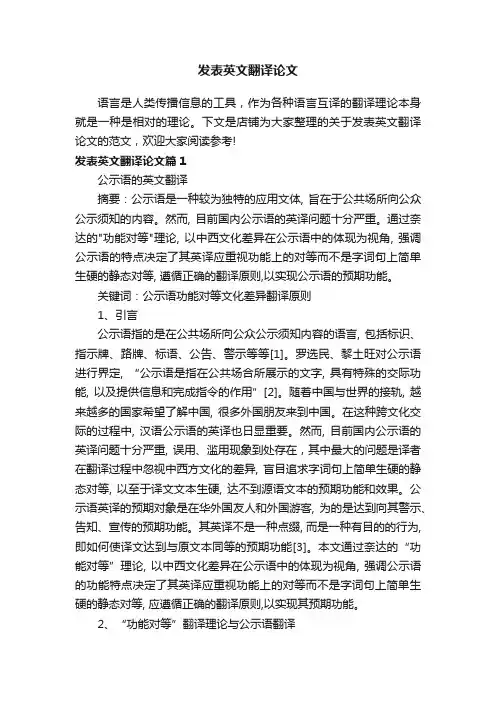
发表英文翻译论文语言是人类传播信息的工具,作为各种语言互译的翻译理论本身就是一种是相对的理论。
下文是店铺为大家整理的关于发表英文翻译论文的范文,欢迎大家阅读参考!发表英文翻译论文篇1公示语的英文翻译摘要:公示语是一种较为独特的应用文体, 旨在于公共场所向公众公示须知的内容。
然而, 目前国内公示语的英译问题十分严重。
通过奈达的"功能对等"理论, 以中西文化差异在公示语中的体现为视角, 强调公示语的特点决定了其英译应重视功能上的对等而不是字词句上简单生硬的静态对等, 遵循正确的翻译原则,以实现公示语的预期功能。
关键词:公示语功能对等文化差异翻译原则1、引言公示语指的是在公共场所向公众公示须知内容的语言, 包括标识、指示牌、路牌、标语、公告、警示等等[1]。
罗选民、黎土旺对公示语进行界定, “公示语是指在公共场合所展示的文字, 具有特殊的交际功能, 以及提供信息和完成指令的作用”[2]。
随着中国与世界的接轨, 越来越多的国家希望了解中国, 很多外国朋友来到中国。
在这种跨文化交际的过程中, 汉语公示语的英译也日显重要。
然而, 目前国内公示语的英译问题十分严重, 误用、滥用现象到处存在,其中最大的问题是译者在翻译过程中忽视中西方文化的差异, 盲目追求字词句上简单生硬的静态对等, 以至于译文文本生硬, 达不到源语文本的预期功能和效果。
公示语英译的预期对象是在华外国友人和外国游客, 为的是达到向其警示、告知、宣传的预期功能。
其英译不是一种点缀, 而是一种有目的的行为, 即如何使译文达到与原文本同等的预期功能[3]。
本文通过奈达的“功能对等”理论, 以中西文化差异在公示语中的体现为视角, 强调公示语的功能特点决定了其英译应重视功能上的对等而不是字词句上简单生硬的静态对等, 应遵循正确的翻译原则,以实现其预期功能。
2、“功能对等”翻译理论与公示语翻译公示语作为一个信息时代和经济全球化时代的标志之一, 公开面对公众, 给予公众行为需求的文字信息传递。

有关英汉翻译论文范文一:生态学视域下的英汉翻译一、引言:英汉翻译研究生态学视域的成立生态学是研究物质与周围环境关系的一门科学,其发轫之初很长时间里被用于自然科学研究。
而随着生态学的发展和交叉、跨学科研究日趋成熟,社会科学的研究者们发现了生态学与人文社会科学的相容性,认为人文社会领域和自然一样,事物与事物、事物与环境间都发生着联系,没有独立于环境之外的事物和现象,故而认为生态学研究的理论、方法同样适用于社会科学研究。
生态学研究与社会科学研究遂真正结合起来。
20世纪50年代以来,人们对文本的认识由仅仅关注认识文本内部自足性问题发展到研究文本内外部关联问题,研究的视野也随之由微观文字向宏观文化转向,人们对文本的认识,已无法将文本语言与该语言所蕴含或显现的某国或某民族的文化相割断。
对于成功的翻译者来说,他不仅要作为两种语言的专家,还要是两种语言各自代表的文化的熟知者。
对于英汉翻译的研究者来说,他们需要不断探寻着解释原文本与译文本之间形成文化差异的依据———这些依据就是社会各层面因素影响文本文字的关系。
生态学强调事物与其环境协调、互动、互相促进。
在英汉翻译领域,一个成功或优秀的译作应当是不仅内部自足和谐发展,而且内部与外部互惠互利、共生共栖的文本。
其动态性体现在这种交互作用是永无止息、不断旋螺式发展的,而非一成不变或者无意义的重复。
用生态学视角看待英汉翻译,为的是建立一种整体性思维。
有学者为“整体性”的意义进行了阐释:“整体性是生命的基本属性,整体性不是部分的简单累加,也不是由外力推动而形成的原子集合体,它有着超越部分之和的更为丰富的内涵和属性。
”对翻译及其研究工作来说,把握“整体性”是关键。
翻译活动涵盖原文本和译文本,涉及原文作者、译者、译文读者3方,包括语言和文化2个层面,同时受到政治环境、经济环境、主流意识形态等的影响。
梳理和廓清这些形成翻译活动的要素的动态平衡发展,有助于建构英汉翻译研究的生态学视域。

毕业论文英文翻译专业范文商务英语翻译教学应注重拓展学生的商务专业知识,加深学生对不同商务体裁语篇的理解和感知。
下文是店铺为大家整理的关于毕业论文英文翻译的范文,欢迎大家阅读参考!毕业论文英文翻译篇1跨文化现象在商务英语翻译教学中的影响[摘要] 跨文化现象是社会交往的产物,在商务英语翻译的社会行为中,必然会受到跨文化现象的影响。
商务英语作为专业英语,自身具有专业性、客观性与时效性的特点,因此在进行商务英语翻译教学的时候,就必须根据商务英语的特点,注意跨文化现象在源语言和目的语言之间的作用,使翻译能达到“信、达、雅”的要求。
[关键词] 跨文化现象;商务英语翻译;教学对于语言学习者而言,语言的学习和文化的融合是一个统一的过程。
在语言学习的过程中,学习者不断地接受外来的文化,并与自身的文化不断碰撞,产生新的文化认识。
因此,没有脱离文化的语言学习,也没有离开语言工具的文化交流。
另一方面,商务英语以其自身的专业特点,形成特定的翻译方法,在教学过程当中,商务英语翻译和其他英语翻译的教学有着很大的区别。
作为商务英语的教学人员,要处理好翻译过程中跨文化现象所带来的问题,商务英语的特点和跨文化现象共同构成了处理好商务英语翻译教学的关键点。
一、跨文化现象的客观存在语言是文化的载体,语言担负起了文化传承的重任。
作为语言学习者,忽略文化学习语言,是不可能真正地把语言学好,学透。
胡文仲在《跨文化交际学概论》中提到:“只注意语言的形式,而不注意语言的内涵是学不好外语的”。
跨文化是社会交往的产物。
跨文化交往包括了跨种族、跨国家、跨民族、跨地区的交往,甚至人与人之间的交往本身都是两种不同的个人文化之间相互影响、相互融合的过程。
只要个体与个体之间进行交往,就会出现跨文化现象。
因此,我们必须有跨文化交往的自觉性。
在多元文化的影响下,无论从事任何行业,都会面对多元文化所带来的冲击。
而语言学习者可以说是首当其冲。
翻译作为语言学习的重要方面,自然要通过语言的形式,看到语言的内涵。

石河子大学毕业论文题目:如何处理英翻汉中的省略How to Deal with Ellipsis inEnglish-Chinese Translation院(系):外国语学院专业:英语班级:20095学号:2009051431姓名:指导教师:完成日期: 2013年5月6日ContentsI. Introduction (1)II. Literature Review (2)III. The Principles of Ellipsis (4)A. Omitted words must be useless and unnecessary in the translated works. (5)B. The meaning of the omitted words is implied in the test. (5)C. Omitted words are self-evident. (5)IV. The functions and application of ellipsis (5)A. The Coherence of the Meaning of Expression (6)B. The Coincidence of the Manner of Expression (6)1. Ellipsis of Articles (6)2. Ellipsis of Prepositions (7)3. Ellipsis of Pronouns (7)a. Ellipsis of Personal Pronouns (7)b. Ellipsis of Impersonal Indefinite Pronouns (8)c. Ellipsis of Relative Pronouns (8)4. Ellipsis of Conjunctions (9)a. Ellipsis of Coordinating Conjunctions (9)b. Ellipsis of Subordinate Conjunctions (9)5. Ellipsis of Rhetorics (9)V. Conclusion (10)Works Cited (11)AbstractWith the development of globalization, the world's political, economic and cultural communications are becoming increasingly frequent. Meanwhile, the role of translation cannot be ignored. Due to language and cultural disparity, reasonable translation is particularly important. How to deal with ellipsis in translation is one of the important aspects. The paper will explore ellipsis in English-Chinese translation from five aspects, which are ellipsis of pronouns, conjunctions, articles, prepositions, modifications, so as to achieve the purpose of smoother and clearer communication among China and English-speaking countries.Key words: cultural disparity; translation; ellipsis摘要随着全球化的不断发展,各国之间的政治、经济、文化交流日渐频繁。
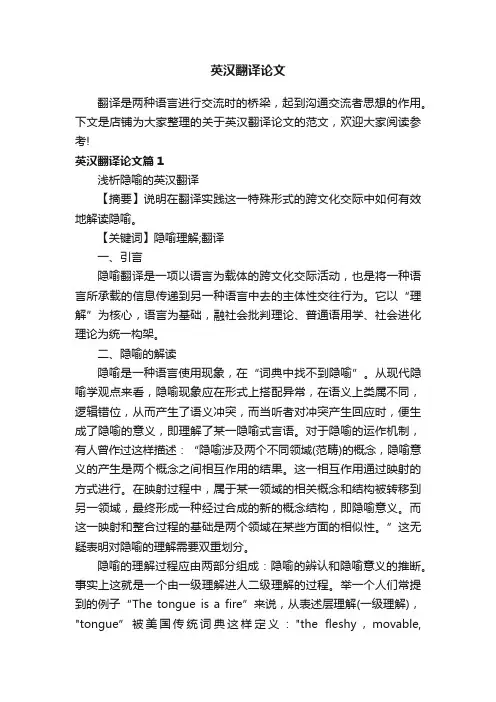
英汉翻译论文翻译是两种语言进行交流时的桥梁,起到沟通交流者思想的作用。
下文是店铺为大家整理的关于英汉翻译论文的范文,欢迎大家阅读参考!英汉翻译论文篇1浅析隐喻的英汉翻译【摘要】说明在翻译实践这一特殊形式的跨文化交际中如何有效地解读隐喻。
【关键词】隐喻理解;翻译一、引言隐喻翻译是一项以语言为载体的跨文化交际活动,也是将一种语言所承载的信息传递到另一种语言中去的主体性交往行为。
它以“理解”为核心,语言为基础,融社会批判理论、普通语用学、社会进化理论为统一构架。
二、隐喻的解读隐喻是一种语言使用现象,在“词典中找不到隐喻”。
从现代隐喻学观点来看,隐喻现象应在形式上搭配异常,在语义上类属不同,逻辑错位,从而产生了语义冲突,而当听者对冲突产生回应时,便生成了隐喻的意义,即理解了某一隐喻式言语。
对于隐喻的运作机制,有人曾作过这样描述:“隐喻涉及两个不同领域(范畴)的概念,隐喻意义的产生是两个概念之间相互作用的结果。
这一相互作用通过映射的方式进行。
在映射过程中,属于某一领域的相关概念和结构被转移到另一领域,最终形成一种经过合成的新的概念结构,即隐喻意义。
而这一映射和整合过程的基础是两个领域在某些方面的相似性。
”这无疑表明对隐喻的理解需要双重划分。
隐喻的理解过程应由两部分组成:隐喻的辨认和隐喻意义的推断。
事实上这就是一个由一级理解进人二级理解的过程。
举一个人们常提到的例子“The tongue is a fire”来说,从表述层理解(一级理解),"tongue”被美国传统词典这样定义:"the fleshy,movable,muscular organ, attached in most vertebrates to the floor of the mouth, that is principal organ of taste,important organ of speech"。
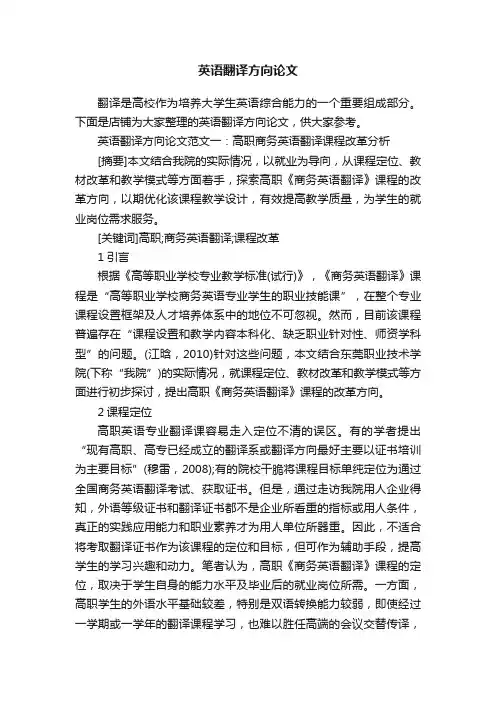
英语翻译方向论文翻译是高校作为培养大学生英语综合能力的一个重要组成部分。
下面是店铺为大家整理的英语翻译方向论文,供大家参考。
英语翻译方向论文范文一:高职商务英语翻译课程改革分析[摘要]本文结合我院的实际情况,以就业为导向,从课程定位、教材改革和教学模式等方面着手,探索高职《商务英语翻译》课程的改革方向,以期优化该课程教学设计,有效提高教学质量,为学生的就业岗位需求服务。
[关键词]高职;商务英语翻译;课程改革1引言根据《高等职业学校专业教学标准(试行)》,《商务英语翻译》课程是“高等职业学校商务英语专业学生的职业技能课”,在整个专业课程设置框架及人才培养体系中的地位不可忽视。
然而,目前该课程普遍存在“课程设置和教学内容本科化、缺乏职业针对性、师资学科型”的问题。
(江晗,2010)针对这些问题,本文结合东莞职业技术学院(下称“我院”)的实际情况,就课程定位、教材改革和教学模式等方面进行初步探讨,提出高职《商务英语翻译》课程的改革方向。
2课程定位高职英语专业翻译课容易走入定位不清的误区。
有的学者提出“现有高职、高专已经成立的翻译系或翻译方向最好主要以证书培训为主要目标”(穆雷,2008);有的院校干脆将课程目标单纯定位为通过全国商务英语翻译考试、获取证书。
但是,通过走访我院用人企业得知,外语等级证书和翻译证书都不是企业所看重的指标或用人条件,真正的实践应用能力和职业素养才为用人单位所器重。
因此,不适合将考取翻译证书作为该课程的定位和目标,但可作为辅助手段,提高学生的学习兴趣和动力。
笔者认为,高职《商务英语翻译》课程的定位,取决于学生自身的能力水平及毕业后的就业岗位所需。
一方面,高职学生的外语水平基础较差,特别是双语转换能力较弱,即使经过一学期或一学年的翻译课程学习,也难以胜任高端的会议交替传译,更不用说同声传译,只适合进行初级的口、笔译工作;另一方面,就我院以往毕业生的就业情况来看,没有专门从事翻译行业的专职译员,所以不能照搬培养专职译员的外语专业本科或研究生人才培养模式来对高职学生进行教学,而应该按实际情况来做出切实的课程定位,以指导该课程的开展,培养毕业生工作所需的相应翻译能力。
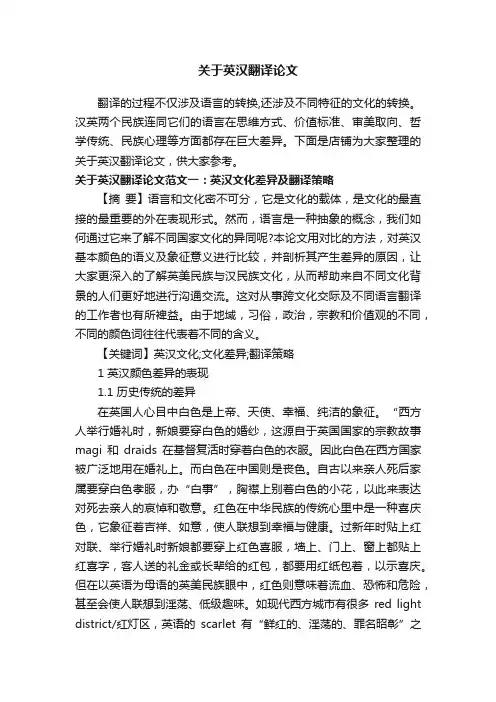
关于英汉翻译论文翻译的过程不仅涉及语言的转换,还涉及不同特征的文化的转换。
汉英两个民族连同它们的语言在思维方式、价值标准、审美取向、哲学传统、民族心理等方面都存在巨大差异。
下面是店铺为大家整理的关于英汉翻译论文,供大家参考。
关于英汉翻译论文范文一:英汉文化差异及翻译策略【摘要】语言和文化密不可分,它是文化的载体,是文化的最直接的最重要的外在表现形式。
然而,语言是一种抽象的概念,我们如何通过它来了解不同国家文化的异同呢?本论文用对比的方法,对英汉基本颜色的语义及象征意义进行比较,并剖析其产生差异的原因,让大家更深入的了解英美民族与汉民族文化,从而帮助来自不同文化背景的人们更好地进行沟通交流。
这对从事跨文化交际及不同语言翻译的工作者也有所裨益。
由于地域,习俗,政治,宗教和价值观的不同,不同的颜色词往往代表着不同的含义。
【关键词】英汉文化;文化差异;翻译策略1 英汉颜色差异的表现1.1 历史传统的差异在英国人心目中白色是上帝、天使、幸福、纯洁的象征。
“西方人举行婚礼时,新娘要穿白色的婚纱,这源自于英国国家的宗教故事magi和draids在基督复活时穿着白色的衣服。
因此白色在西方国家被广泛地用在婚礼上。
而白色在中国则是丧色。
自古以来亲人死后家属要穿白色孝服,办“白事”,胸襟上别着白色的小花,以此来表达对死去亲人的哀悼和敬意。
红色在中华民族的传统心里中是一种喜庆色,它象征着吉祥、如意,使人联想到幸福与健康。
过新年时贴上红对联、举行婚礼时新娘都要穿上红色喜服,墙上、门上、窗上都贴上红喜字,客人送的礼金或长辈给的红包,都要用红纸包着,以示喜庆。
但在以英语为母语的英美民族眼中,红色则意味着流血、恐怖和危险,甚至会使人联想到淫荡、低级趣味。
如现代西方城市有很多red light district/红灯区,英语的scarlet有“鲜红的、淫荡的、罪名昭彰”之意。
由此可见,因历史传统的不同,英汉两民族对待颜色的态度也大相径庭。
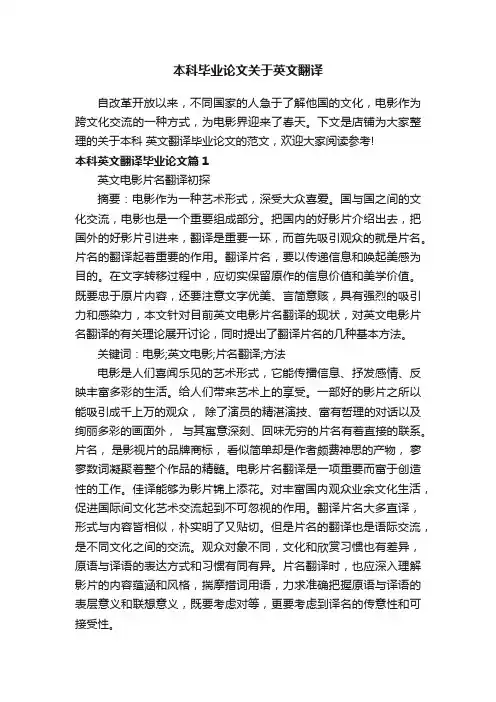
本科毕业论文关于英文翻译自改革开放以来,不同国家的人急于了解他国的文化,电影作为跨文化交流的一种方式,为电影界迎来了春天。
下文是店铺为大家整理的关于本科英文翻译毕业论文的范文,欢迎大家阅读参考!本科英文翻译毕业论文篇1英文电影片名翻译初探摘要:电影作为一种艺术形式,深受大众喜爱。
国与国之间的文化交流,电影也是一个重要组成部分。
把国内的好影片介绍出去,把国外的好影片引进来,翻译是重要一环,而首先吸引观众的就是片名。
片名的翻译起着重要的作用。
翻译片名,要以传递信息和唤起美感为目的。
在文字转移过程中,应切实保留原作的信息价值和美学价值。
既要忠于原片内容,还要注意文字优美、言简意赅,具有强烈的吸引力和感染力,本文针对目前英文电影片名翻译的现状,对英文电影片名翻译的有关理论展开讨论,同时提出了翻译片名的几种基本方法。
关键词:电影;英文电影;片名翻译;方法电影是人们喜闻乐见的艺术形式,它能传播信息、抒发感情、反映丰富多彩的生活。
给人们带来艺术上的享受。
一部好的影片之所以能吸引成千上万的观众,除了演员的精湛演技、富有哲理的对话以及绚丽多彩的画面外,与其寓意深刻、回味无穷的片名有着直接的联系。
片名,是影视片的品牌商标,看似简单却是作者颇费神思的产物,寥寥数词凝聚着整个作品的精髓。
电影片名翻译是一项重要而富于创造性的工作。
佳译能够为影片锦上添花。
对丰富国内观众业余文化生活,促进国际间文化艺术交流起到不可忽视的作用。
翻译片名大多直译,形式与内容皆相似,朴实明了又贴切。
但是片名的翻译也是语际交流,是不同文化之间的交流。
观众对象不同,文化和欣赏习惯也有差异,原语与译语的表达方式和习惯有同有异。
片名翻译时,也应深入理解影片的内容蕴涵和风格,揣摩措词用语,力求准确把握原语与译语的表层意义和联想意义,既要考虑对等,更要考虑到译名的传意性和可接受性。
一、英文电影片名翻译现状(一)一片多名的问题日前,电影片名翻译中存在着混乱、不规范的现象,一片多名的问题较突出。
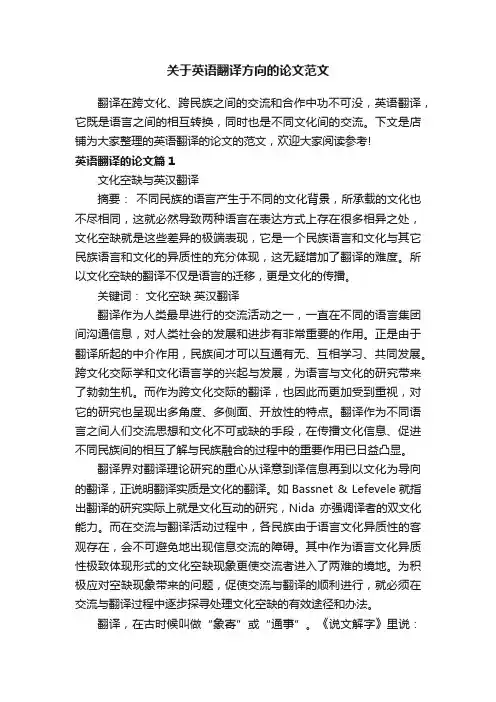
关于英语翻译方向的论文范文翻译在跨文化、跨民族之间的交流和合作中功不可没,英语翻译,它既是语言之间的相互转换,同时也是不同文化间的交流。
下文是店铺为大家整理的英语翻译的论文的范文,欢迎大家阅读参考!英语翻译的论文篇1文化空缺与英汉翻译摘要:不同民族的语言产生于不同的文化背景,所承载的文化也不尽相同,这就必然导致两种语言在表达方式上存在很多相异之处,文化空缺就是这些差异的极端表现,它是一个民族语言和文化与其它民族语言和文化的异质性的充分体现,这无疑增加了翻译的难度。
所以文化空缺的翻译不仅是语言的迁移,更是文化的传播。
关键词:文化空缺英汉翻译翻译作为人类最早进行的交流活动之一,一直在不同的语言集团间沟通信息,对人类社会的发展和进步有非常重要的作用。
正是由于翻译所起的中介作用,民族间才可以互通有无、互相学习、共同发展。
跨文化交际学和文化语言学的兴起与发展,为语言与文化的研究带来了勃勃生机。
而作为跨文化交际的翻译,也因此而更加受到重视,对它的研究也呈现出多角度、多侧面、开放性的特点。
翻译作为不同语言之间人们交流思想和文化不可或缺的手段,在传播文化信息、促进不同民族间的相互了解与民族融合的过程中的重要作用已日益凸显。
翻译界对翻译理论研究的重心从译意到译信息再到以文化为导向的翻译,正说明翻译实质是文化的翻译。
如Bassnet & Lefevele就指出翻译的研究实际上就是文化互动的研究,Nida亦强调译者的双文化能力。
而在交流与翻译活动过程中,各民族由于语言文化异质性的客观存在,会不可避免地出现信息交流的障碍。
其中作为语言文化异质性极致体现形式的文化空缺现象更使交流者进入了两难的境地。
为积极应对空缺现象带来的问题,促使交流与翻译的顺利进行,就必须在交流与翻译过程中逐步探寻处理文化空缺的有效途径和办法。
翻译,在古时候叫做“象寄”或“通事”。
《说文解字》里说:“传译四夷之言者。
”《义疏》里也提到:“译即易,谓换易言语使相解也。
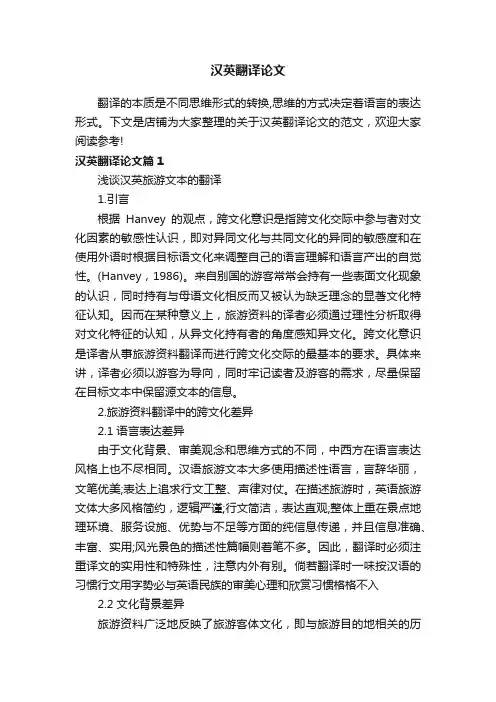
汉英翻译论文翻译的本质是不同思维形式的转换,思维的方式决定着语言的表达形式。
下文是店铺为大家整理的关于汉英翻译论文的范文,欢迎大家阅读参考!汉英翻译论文篇1浅谈汉英旅游文本的翻译1.引言根据Hanvey的观点,跨文化意识是指跨文化交际中参与者对文化因素的敏感性认识,即对异同文化与共同文化的异同的敏感度和在使用外语时根据目标语文化来调整自己的语言理解和语言产出的自觉性。
(Hanvey,1986)。
来自别国的游客常常会持有一些表面文化现象的认识,同时持有与母语文化相反而又被认为缺乏理念的显著文化特征认知。
因而在某种意义上,旅游资料的译者必须通过理性分析取得对文化特征的认知,从异文化持有者的角度感知异文化。
跨文化意识是译者从事旅游资料翻译而进行跨文化交际的最基本的要求。
具体来讲,译者必须以游客为导向,同时牢记读者及游客的需求,尽量保留在目标文本中保留源文本的信息。
2.旅游资料翻译中的跨文化差异2.1 语言表达差异由于文化背景、审美观念和思维方式的不同,中西方在语言表达风格上也不尽相同。
汉语旅游文本大多使用描述性语言,言辞华丽,文笔优美;表达上追求行文工整、声律对仗。
在描述旅游时,英语旅游文体大多风格简约,逻辑严谨;行文简洁,表达直观;整体上重在景点地理环境、服务设施、优势与不足等方面的纯信息传递,并且信息准确、丰富、实用;风光景色的描述性篇幅则着笔不多。
因此,翻译时必须注重译文的实用性和特殊性,注意内外有别。
倘若翻译时一味按汉语的习惯行文用字势必与英语民族的审美心理和欣赏习惯格格不入2.2 文化背景差异旅游资料广泛地反映了旅游客体文化,即与旅游目的地相关的历史文化、建筑文化、园林文化、宗教文化、民俗文化、文学艺术、娱乐文化和人文化的自然景观等。
这与旅游主体(即旅游者)文化相差甚远,在吸引旅游者的同时也会构成了跨文化理解的障碍。
旅游资料中介绍的历史典故、风土人情、价值观念等等无不反映了独特的文化含义,有些甚至在中国尚且鲜有人知,更不用说来自不同文化背景的外国游客。
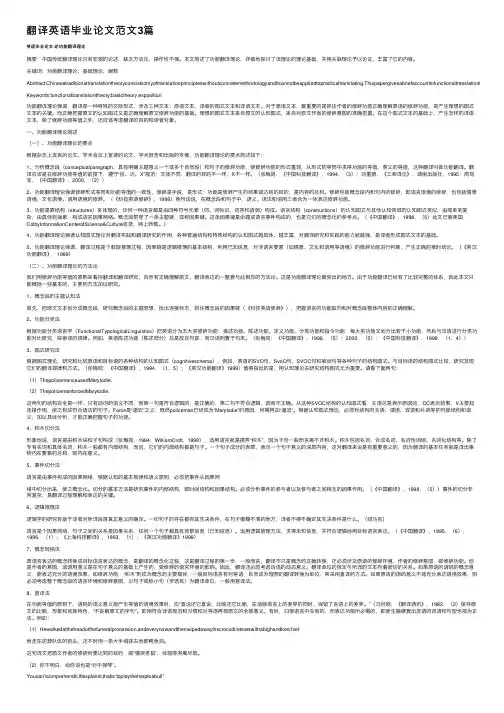
翻译英语毕业论⽂范⽂3篇英语毕业论⽂:论功能翻译理论摘要:中国传统翻译理论只有宏观的论述,缺乏⽅法论,操作性不强。
本⽂简述了功能翻译理论,详细地探讨了该理论的理论基础,并⽤关联理论予以论证,丰富了它的内容。
关键词:功能翻译理论;基础理论;阐释Abstract:Chinesetraditionaltranslationtheoryconsistsonlyoftranslationprincipleswithoutconcretemethodologyanditcannotbeappliedtopracticaltranslating.Thispapergivesabriefaccounttofunctionaltranslationtheory,prob Keywords:functionaltranslationtheory;basictheory;exposition功能翻译理论强调,翻译是⼀种特殊的交际形式,涉及三种⽂本:原语⽂本、译者的图式⽂本和译语⽂本。
对于原语⽂本,最重要的是抓住作者的修辞功能正确理解原语的修辞功能,是产⽣理想的图式⽂本的关键。
⽽正确把握原⽂的认知图式⼜是正确理解原⽂修辞功能的基础。
理想的图式⽂本来⾃原⽂的认知图式,来⾃对原⽂作者的修辞意图的准确把握。
在这个图式⽂本的基础上,产⽣怎样的译语⽂本,除了修辞功能等值之外,还应该考虑翻译的⽬的和读者对象。
⼀、功能翻译理论简述(⼀)、功能翻译理论的要点根据杂志上发表的论⽂、学术会议上宣读的论⽂、学术报告和出版的专著,功能翻译理论的要点简述如下:1、分析概念段(conceptualparagraph,具有明确主题意义⼀个或多个⾃然段)和句⼦的修辞功能,使修辞功能的形式重现,从形式的等同中求得功能的等值,意义的等值,这种翻译叫做功能翻译。
翻译应该是在修辞功能等值的前提下,遵守“信、达、X”规范;⽂体不同,翻译的⽬的不⼀样,X不⼀样。
关于英语翻译方向的论文范文(2)英语翻译的论文篇3浅谈职业教育商务英语翻译人才的培养模式0 前言目前对商务英语的培养我们主要是以相关的课程辅导为主,比如说“商务英语翻译”主要阐述的是一些国家的基本的商务模式,以及语言习惯问题,主要是提高人才的商务能力和翻译能力,保障商务英语专业人才能够正确传达客户之间的交流信息,保障双方的利益。
然而由于长期受传统的培养模式的影响,商务英语人才的培养并没有那么容易。
基于这种情况,研究出一套好的商务英语翻译人才培养的方案是很重要的。
1 商务英语人才在培养过程中常见的一些问题以及解决方法就目前而言主要有下列一些问题:人才在培养的过程中教学知识太过于宽泛,缺乏职业的明确性,没有很强的职业观念。
另一类问题就是在教学的过程中太过于书面化缺少实践的锻炼,同时在人才的考核方面也存在很多缺陷,例如考核的标准太过于单一缺少综合性的体现。
这些都是目前所存在的一些问题,针对这些问题我们提出了一些相对应的措施:首先是加强职业观念的培养,要能够做到专业与职业对口,其次就是要加强实践的力度,可以把一些基本的工作任务分配给学生作为教学的主要内容。
最后就是在人才的考核过程中,我们要实现考核的多样化,提高考核的标准,让能力优先者能够有一个好的平台发挥自己的能力。
1.1 人才培养模式的构建人才的培养最终是服务社会的,所以说在人才培养模式的构建过程中我们需要时刻关注社会的动态与走向,以便培养出来的人才能够更好地服务于社会。
人才培养模式的构建需要我们教师通过多年的教学经验和方法的总结才能构建出来的,长时间地比较各种方法,最后留下高效有用的学习方法。
人才培养模式的构建是需要教育者一起来共同努力的。
在培养的过程中我们要以学生为中心,主要是围绕学生展开一系列的教学活动,力求学生能够在短时间内能够学到大量有用的知识。
以职业能力的培养为主导思想,定义专业的能力标准。
教学主要是以实践任务为主,旨在提高人才的职业能力。
《中英文自然科学论文摘要翻译策略研究》篇一摘要:本文旨在探讨中英文自然科学论文摘要翻译的有效策略。
通过对当前翻译实践的深入分析,结合自然科学领域的特点,提出一套科学、系统的翻译策略。
首先,论文介绍了自然科学领域摘要翻译的重要性和复杂性。
接着,文章探讨了不同翻译策略的优势与局限性,并结合实际案例进行分析。
随后,基于多年来的研究成果和实践经验,提出了针对性强的翻译方法与策略。
本文所提出的策略包括对关键信息的识别、语义准确性的保持、文体和语言风格的适配,以及专业术语的精准翻译等方面。
通过科学严谨的翻译过程,确保原文的学术价值和研究成果在译文中的准确传达。
最后,本文对未来自然科学论文摘要翻译的发展趋势进行了展望,并提出了相应的建议和改进方向。
一、引言随着全球化的推进和学术交流的日益频繁,自然科学论文摘要的翻译质量显得尤为重要。
中英文自然科学论文摘要的翻译不仅要求准确传达原文信息,还要考虑到文化背景、语言习惯和学科特点等因素。
因此,研究有效的翻译策略对于提高翻译质量和促进学术交流具有重要意义。
二、当前翻译策略分析在当前的翻译实践中,常见的翻译策略包括直译、意译和译述相结合的方法。
直译能够保持原文的结构和表达方式,但可能因文化差异造成理解上的困难;意译则更注重目标语言的表达习惯,但可能损失原文的部分信息;而译述相结合的方法则是在保持信息准确性的同时,对原文进行适当的改写和调整。
这些策略各有优劣,需要根据具体语境和内容进行选择。
三、关键翻译策略与方法1. 关键信息识别:在翻译过程中,首先要识别摘要中的关键信息,包括研究目的、方法、结果和结论等,确保这些信息在译文中得到准确传达。
2. 语义准确性:在保证语言流畅的同时,要确保译文的语义准确性,避免因文化差异或语言习惯造成的误解。
3. 文体与语言风格适配:自然科学论文摘要通常具有客观、严谨的语言风格,翻译时要保持这种风格的一致性。
4. 专业术语的精准翻译:对于自然科学领域中的专业术语,要采用公认的译法,确保译文的准确性。
关于英汉翻译的论文英语和汉语是两种高度发展的语言,对比其异同,对于英语翻译教学是很重要的。
下文是店铺为大家整理的关于英汉翻译的论文的范文,欢迎大家阅读参考!关于英汉翻译的论文篇1英汉语言的异同及其翻译策略在英汉翻译中,两种语言在词汇方面的不同主要体现在词的意义,词的顺序和词的搭配能力三个方面;从句法方面来说,英语和汉语在句子结构,句子顺序和其他一些表达方式上则有各自的特点。
下面笔者就从词汇现象和句法现象两方面来探讨英汉的对应程度如何,以及根据这些对比,在进行翻译实践时,应该运用哪些翻译技巧。
1、英汉语言的对比1.1英汉词汇现象的对比首先,从词的意义方面来看。
词汇作为语言的三要素之一,相比于语音和语法,它的变化最快。
随着社会和科学的不断发展和变化,在语言中一方面增加了新词,一方面旧词增添了新的意义。
人类发明轮船以前,用的是帆船,英语“sail”一词原意为“帆”,短语“setsail”,就有张帆起航之意。
但是随着社会的发展,帆船逐渐被用煤,柴油,甚至是用核动力的轮船所代替。
自从潜艇出现后,“sail”这个词又增添了“潜艇指挥塔”的新含义。
这就是词义的发展变化,我们在对比英汉语言时,应该明确它们的对应情况是随着时间的变迁和社会的发展而发展变化着的。
英语词汇在汉语里的对应程度,大致可以归纳为四种情况。
第一,完全对应。
英语中的词所表达的意义,可以在汉语里找到完全对应的词来表达。
如“computationallinguistics”(计算语言学),“TheU.S.StateDepartment”(美国国务院)。
这主要是一些已有通用译名的专用名词,术语和生活中常见事物名称等。
第二,部分对应。
英语中有些词和汉语中的词汇在词义上只能部分对应,体现在有广义和狭义之分。
如“morning”(上午,早晨),“gun”(枪,炮),一个英语单词相对应有较多的汉语意义.第三,无对应。
英语中有些词或汉语里有些词在对方语言里找不到对应的词来表达。
关于英语翻译专业毕业论文翻译是指两种不同语言的相互转换,是实现不同文化之间相互交流的关键。
下面是店铺为大家整理的英语翻译专业毕业论文,供大家参考。
英语翻译专业毕业论文范文一:多媒体技术与英语翻译专业教学结合的思考摘要:实践表明,运用互联网进行英语教学可使教学内容化远为近、化虚为实、化静为动、化抽象为具体、化宏观为微观,使英语教学从单一的模式向直观性、趣味性、艺术性和立体化模式发展。
接下来,本文将结合多媒体在英语教学中的作用,探讨多媒体技术与英语翻译课堂教学有效结合的方法以及对策。
关键词:多媒体;翻译;教学;作用;有效结合1前言随着社会的发展以及教育的深入改革,传统教学环境下的教学模式已经不能好地满足社会的发展以及需求,因此,为了更好地改善课堂教学质量,提升课堂教学效果,很多教师开始选择将多媒体技术引入到课堂中来,进而实现多媒体技术与英语翻译课堂教学的有效结合。
我们都知道,多媒体技术本身就具有信息载体多样性的特点,即将文字、文本、图形、图像、视频、语音等多种媒体信息于一体。
这种将书本上的文字以音频、视频或者图画的形式展现出来的功能会使得我们的英语翻译课堂教学变得更加生动形象。
2多媒体在英语翻译课堂教学中的作用2.1激发学生学习兴趣我们都知道,传统的教学环境下,教师大都是凭借书本上的知识照本宣科的进行讲解。
这种书本教学法虽然可以知识教学内容的讲授,但是却使得课堂教学变得十分单调、枯燥,进而导致学生学习兴趣的降低。
我们都知道,多媒体技术具有将文本、文字、图形、视频以及音频进行整合的功能,因此,教师可以将原本课本上的知识以生动形象的形式展现给大家,进而增强课堂的趣味性以及活泼性。
同时,这种生动的教学形式还可以吸引学生的注意力,进而激发学生的学习兴趣。
2.2创建良好的学习氛围传统的教学环境下,教师为了节省课堂的教学时间,大都采用“满堂灌”以及“一言堂”教学模式,与学生之间缺乏一定的互动,进而导致课堂的教学氛围极其沉闷。
英语翻译方向毕业论文I. IntroductionIn recent years, the field of English translation has gained significant attention due to globalization and increased international communication. As a result, the demand for professional English translation services has reached unprecedented levels. This paper aims to explore the challenges and techniques involved in English translation, with a focus on the importance of cultural understanding.II. Challenges in English TranslationTranslating from one language to another is a complex process that involves various challenges. One of the main difficulties in English translation lies in accurately conveying the meaning and nuances of the source text. English is a language rich in idioms, metaphors, and cultural references that may not have direct equivalents in other languages. Translators must find creative ways to capture the essence of these expressions in the target language.Another challenge is maintaining the style and tone of the original text. English literature, for example, encompasses a wide range of writing styles, from formal academic texts to colloquial dialogues. Translators must have a deep understanding of the target audience and the intended effect of the text in order to reproduce the appropriate tone and style.III. Techniques in English TranslationTo overcome the challenges faced in English translation, translators utilize various techniques. These include semantic and syntactic analysis, cultural adaptation, and naturalization.Semantic and syntactic analysis involves a thorough understanding of the source text's structure and meaning. Translators must analyze the sentence structure, word choice, and overall context to accurately convey the intended message. This often requires specialized knowledge in the subject matter to ensure accurate translation.Cultural adaptation is crucial in English translation, as it involves understanding the cultural references and idiomatic expressions that may not exist in the target language. Translators must find suitable equivalents or provide explanations to bridge the cultural gap. This requires extensive research and experience in both the source and target cultures.Naturalization refers to the process of making the translation sound natural and idiomatic in the target language. Translators must consider the linguistic conventions and stylistic preferences of the target language to create a translation that flows smoothly and resonates with the target audience.IV. Importance of Cultural UnderstandingOne of the key aspects of successful English translation is cultural understanding. Language is deeply intertwined with culture, and without proper cultural understanding, translation can lead to misinterpretations and misunderstandings. Translators must familiarize themselves with the cultural context of the source text and make appropriate adjustments to ensure accuracy and appropriateness in the target language.Cultural understanding also extends to the target audience. Translators must consider the cultural norms, beliefs, and preferences of the intended readers to ensure the translation resonates with them effectively. This can include adapting metaphors, using appropriate cultural references, and even adjusting the overall tone of the translation to suit the target audience's cultural expectations.V. ConclusionEnglish translation is a challenging yet essential field that plays a vital role in global communication. Translators must overcome various challenges by utilizing techniques such as semantic and syntactic analysis, cultural adaptation, and naturalization. Additionally, cultural understanding is paramount in achieving accurate and effective translations. Through continuous learning and experience, translators can contribute to bridging the linguistic and cultural gaps in our increasingly interconnected world.。
英汉翻译论⽂范⽂ 英汉翻译过程包括理解和表达两个重要的阶段,只有在正确理解原⽂词义的基础上,才能正确地表达原⽂。
下⽂是店铺为⼤家整理的关于英汉翻译论⽂范⽂的内容,欢迎⼤家阅读参考! 英汉翻译论⽂范⽂篇1 探析英汉翻译陷阱 【摘要】英语陷阱的表现形式多种多样,常常是句⼦或词语的表层结构与其要表达的真实含义相反。
为了避免落⼊英语陷阱,学习者对英语的某些词句、语义应克服表⾯化的理解,也不能简单照搬辞典上的释义,更不能望⽂⽣义;对中西⽂化差异也必须有深刻的了解。
只要对英语陷阱多注意、多分析、多体会,便可避免误⼊⼀些似是⽽⾮的“陷阱”。
【关键词】英汉翻译;陷阱;表层结构;深层含义 英语陷阱的表现形式多种多样,对学习者来说的确是⼀个必须要注意的问题。
在英汉翻译中,初学者往往从语法⾓度对英汉两种语⾔做机械对⽐,有时还下意识地将词典释义不加斟酌,拿来就⽤。
在审查译⽂表达是否准确时,⼜习惯于将⾃⼰的母语思维定势⽤作衡量正误的标准。
这些做法实际上都很容易造成释义与原⽂真实含义的脱节,甚⾄南辕北辙,落⼊英语“陷阱”。
⼀、短语翻译中的陷阱 例⼦如下: 1、confidence man 误译:值得信赖的⼈ 正译:骗⼦ 2、sleep late 误译:睡觉很晚 正译:起床很晚 3、black tea 误译:⿊茶 正译:红茶 4、gas mask 误译:赌⽓⾯具 正译:防毒⾯具 5、mad-doctor 误译:发疯的医⽣ 正译:精神病医师 6、lightning rod 误译:闪电针 正译:避雷针 7、trouble man 误译:制造⿇烦的⼈ 正译:故障检修员 8、be in control 误译:被控制 正译:掌控……,控制…… 9、flu mask 误译:流感⼝罩 正译:卫⽣器具 10、fire engine 误译:点⽕机器 正译:救⽕车、消防车 11、fire wall 误译:着⽕的墙 正译:防⽕墙 对这些短语均须准确理解,否则便会落⼊陷阱之中。
南京邮电大学毕业论文题目零碎话语的翻译探讨专业英语学生姓名班级学号指导教师指导单位英语系日期: 2012年 3月 12日至 2012 年 6 月 15 日AcknowledgementIn writing this thesis, I received much advice, support and encouragement from a number of people. I hereby present my sincere gratitude to those who have given me a hand on the writing of this thesis.My sincere gratitude first and foremost goes to my supervisor Wu Jian for his guidance and instruction. I would also like to extend my appreciation to all the teachers in the Foreign Languages Department, whose inspiring lectures gave me a holistic overview concerning linguistics and translation theories.Last but not least, I am very grateful to my beloved family and roommates who give me great help in various ways. It is with their support that I can accomplish this task.AbstractIn literary works, certain information stands out because it violates the norm of language usage, and such writing technique is called foregrounding. Sentence fragmentation is not a grammatically full sentence but is nevertheless punctuated like one. In this sense, fragment is one kind of foregrounding.As Eugene Nida said, ―translating consists in reproducing in the receptor language the closest natural equivalent of the source language message, first in terms of meaning and secondly in terms of style‖, a qualified translator should not only transmit the meaning but also extract to the utmost the poetic values of the original works. However, some foregrounding features in literary works are often overlooked by translators, and fragment is no exception. In order to produce a better translation, fragment‘s function should be recognized first and represented properly in the target text.In this thesis, 16 types of fragments are listed. And functions of them are analyzed. There are four kinds of function: information; language power enhancement; stylistic embodiment; and theme and plot assistance.After that, two translation principles are introduced. The first principle is that the form of fragments should be reserved. This principle is based on equivalent effect theory. However, to reserve the form does not mean fragments need to be translated literally. The second principle is that considering readers‘acceptability, some fragments should be translated with a little adjustment.Based on examples taken from English literary works and their Chinese versions, this thesis provides a tentative study on sentence fragmentation translation. It is aimed to bring attention to the translation of fragments and to provide a fresh perspective on foregrounding studies.Key words: Sentence fragmentation; Foregrounding; Translation of style摘要在文学作品中,某些信息由于打破了语言常规而格外引人注目,这种写作手法叫做“前景化”。
零碎语就是不符合语法规则的句子。
从这点来看,零碎语属于“前景化”的一种。
正如尤金·奈达所说的那样,“所谓翻译,是在译语中用最贴切而又最自然的对等语再现源语的信息,首先是意义,其次是文体”,所以说一个合格的译者不但要翻译信息,还要最大程度地翻译出源语的诗意。
可惜的是,对于文学作品中的“前景化”,包括零碎语,译者经常会忽视。
如果想要翻译出更好的作品,译者首先要认识到零碎语在文章中的作用,其次应该在译文中再现这种作用。
根据从记叙型文学作品中寻找到的例子,本文列举了16种类型的零碎语,并且分析了它在文章中所能起到的作用。
作用分为四种:提供信息、增强语言力量、突出文体特点、协助主旨和情节的叙述。
之后介绍了两条翻译原则。
第一条基于等效理论,说明零碎语的形式应当给予保留。
但是保留形式不代表零碎语一定要直译。
第二条原则考虑了读者的接受能力,说明零碎语在翻译时也需要适当调整。
本文结合英汉文学作品实例,对零碎语翻译进行了尝试性研究,希望能引起译者对零碎语的重视,同时也希望能给“前景化”研究提供新的视角。
关键词: 零碎语; 前景化; 文体翻译Contents Acknowledgements (Ⅰ)Abstract (English) (Ⅱ)Abstract (Chinese) (Ⅲ)Contents (Ⅳ)Chapter 1 Introduction (1)1.1Object of the study (1)1.2Significance of the study (1)1.3Structure of the thesis (1)Chapter 2 Literature Review (3)2.1 Overview of the Previous Researches on Sentence Fragmentation (3)2.1.1 Stylistics (3)2.1.2 Writing Style Manuals (3)2.1.3 Psychology (4)2.2 Overview of the Previous Researches on Foregrounding (4)2.2.1 Linguistic Foregrounding Theory (4)2.2.2 Foregrounding Theory in Literary Translation (5)Chapter 3 Types of Sentence Fragmentation (6)3.1 Direct Speech (6)3.2 Echoic Fragments (6)3.2.1Direct Repetition (6)3.2.2Repetition with Expansion (6)3.2.3Repetition with Paraphrase (7)3.3 Additional Information Without Repetition (7)3.4 Identification of an Under-specified Referent (7)3.5 Fractured-off Components (7)3.6 S tream of Consciousness (7)3.7 Incomplete Narration (8)3.8 Colloquialism (8)3.9 General-Particular and Hypothetical-Real Relation (8)3.10 Evaluation, Conclusion, and Comment (8)3.11 Repairing and Reworking-Negation (9)3.12 Topic Management and Orientation (9)3.13 Discovered Objects, Impression, Memories (9)3.14 Narrated Action Sequences (10)3.15 Dialogic Questions and Responses (10)3.16 Isolated Connectives (10)Chapter 4 Major Functions of Sentence Fragmentation (11)4.1 Information (11)4.2 Language Power Enhancement (11)4.3 Stylistic Embodiment (11)4.4 Theme and Plot Assistance (12)Chapter 5 Fragmentation Translation Principles (14)5.1 Equivalent Effect and Fragment Reservation (14)5.2 Reader Acceptability and Fragment Adjustment (18)Chapter 6 Conclusion (20)7.1 Major Findings (20)7.2 Limitations and Suggestions for Future Endeavor (20)Bibliography (22)On the Translation of Sentence FragmentationChapter 1 Introduction1.1 Object of the StudyThe term ―sentence fragmentation‖ refers to the use of linguistic expressions that are not grammatically full sentences but are nevertheless punctuated like sentences. (Emmott, 2006) This writing style is one specific instance of foregrounding.This article focuses on the Chinese translations of English sentence fragmentations. Examples are mainly from original English narrative fictions.1.2 Significance of the StudyThe interest in sentence fragmentation dates back to the early days of modern stylistics where their study was part of a more general interest in the structure of sentences, particularly in relation to how the simplicity or complexity of sentence could serve stylistic purposes.Nowadays, fragmentations are widely used for rhetorical and stylistic purposes across a wide range of genres, like advertising language, newspaper writing, popular science texts, literary texts and popular fiction, and they are also acknowledged in grammar books and even in recent writing style guides.Despite the increasing interest in sentence fragmentation, few researchers seem to pay attention to its translation. The ignorance of such writing technique and its functions might lead to inadequate translation, which would attenuate or alter altogether what the author meant to convey.1.3 Structure of the ThesisThis thesis is composed of six chapters. Chapter one is the introduction to the object, and significance and outline of the study. Chapter two is a literature review of sentence fragmentation and foregrounding. Chapter three lists 16 types of sentencefragmentation. Chapter four is a discussion about the functions of fragmentation. Chapter five introduces two principles for fragment translation. Chapter seven is a conclusion including major findings and limitations and suggestions for future endeavor.Chapter 2 Literature Review2.1 Overview of the Previous Researches on Sentence Fragmentation2.1.1 StylisticsSentence fragmentation attracted interest in the early days of modern stylistics as part of the study of sentence length. Crystal and Davy (1969) examined fragments in spoken discourse and a range of written texts, using the term ―minor sentence‖. Leech and Short (1981: 217) continued the stylistic analysis of fragmentation in their study of prose fiction, arguing that the punctuation of fragments provides additional emphasis and can suggest ―the rhythm and intonation one would use in reading the texts aloud.‖ Accordi ng to their discussion, fragments are graphological sentences but not syntactic sentences. Since these early studies, stylisticians have continued to observe sentence fragmentation in the process of performing their analysis of specific texts. The study of fragments is hence an accepted part of any stylistician‘s ―tool kit‖ of techniques of analysis and so is of general interest within stylistics.2.1.2 Writing Style ManualsBeyond stylistics, fragmentation is also a concern of writers of style manuals. Traditionally, writing style manuals have warned novice writers against producing fragments, but there is nevertheless a tendency nowadays to acknowledge that there are special stylistic uses of this type of writing in literary texts (e.g., Allen, 2002: 57; King, 2004: 13–14).Fragmentation is sometimes referred to in grammar textbooks, but the handling of this topic is often rather brief, peripheral to the main grammatical discussion of these books, and certainly does not reflect the diversity of use of fragments in written texts. Quirk et al. (1985: 1446) discuss the topic in a section on prosody and punctuation. They contrast ―I saw Miriam and Walter.‖ with ―I saw Miriam. And Walter.‖,arguing that the first suggests a couple who regularly appear together, whereas the second might suggest either that Walter is being mentioned as an afterthought or that the sight of him is being given special or dramatic significance. Quirk et al. claim that these two very different interpretations are context dependent and have different prosodies attached to them in reading. In a section on punctuation, Huddleston and Pullum (2002: 1735) recognize one specific type of fragmentationthat occurs in connected prose, the splitting of a single sentence into two separate compone nts (e.g., ‗He had broken the vase. Deliberately.‘). Huddleston and Pullum‘s explanation is in terms of information packaging, suggesting that the punctuation gives extra importance to the latter element in the same way as prosody could set it apart in speech. They also argue that brevity might be a consideration and might explain the use of fragments in journalism.2.1.3 PsychologyIn psychology, the study of sentence fragmentation has relevance to research on sentence complexity. There is a growing body of empirical research on ―depth of processing‖that shows that readers are less attentive to errors or changes in a text when information is embedded in complex structures, such as subordinate clauses, rather than in main clauses (Sanford and Sturt, 2002; Sturt et al., 2004). On this basis, fragments might be predicted to increase attention due to their brevity and simplicity and also to their ability to extract information that might otherwise have appeared within an earlier full sentence. Researchers have investigated the functionality of short fragments in the Glasgow LINCS Project (Literature, Narrative and Cognitive Science: Interdisciplinary Perspectives on the Nature of Reading). The results show that short fragments serve to grab attention and lead to more substantial mental processing than do phrases in longer sentences.2.2 Overview of the Previous Researches on Foregrounding2.2.1 Linguistic Foregrounding TheoryForegrounding, a term put forward by Czech theorist Jan Mukarovsky (1964), is one of the core assumptions within stylistics.In Linguistics and the Figures of Rhetoric, Leech classifies foregrounding into two kinds: syntagmatic foregrounding and paradigmatic foregrounding. Syntagmatic foregrounding relies on making use of certain linguist ic element out of people‘s expectation so as to achieve variations. Paradigmatic foregrounding relies on selections of linguistic elements beyond the routine (Leech, 1966).In Halliday‘s opinion, foregrounding is motivated prominence (Halliday, 1971). He believes that foregrounding results from two ways: ―deviation from a norm‖ and ―establishment of a norm‖ (1971: 339).In the light of Leech and Short (1981: 48), foregrounding may be qualitative—a breach of some rule or convention of English; or it may also bequantitative—deviance from some expected frequency, namely, overregularity.It is not until 1980 that the theory of foregrounding was introduced to China as one aspect of stylistics. Professor Zhang Delu, Shen Dan, et.al. were some of the pioneers. In 1994, Zhang published Linguistic Semiotics and Foregrounding in Foreign Languages, in which he introduces the notion of foregrounding and states from a functional perspective the importance of foregrounding (Zhang Delu, 1994). Since then, foregrounding has caught more and more attention in China, especially in the field of literary stylistics.2.2.2 Foregrounding Theory in Literary TranslationIn 2001, Professor Ye Zinan proposes in his book Advanced Course in English Translation that the foregrounding theory could be applied to translation (Ye Zinan, 2001). During the translation process, translator should firstly examine the ―text world‖ knowledge (Werth, 1999) in order to clarify the significance of the fragments. Ye Zinan therefore divides foregrounding into two categories: unintentional and intentional. As for unintentional sentence fragments, the language feature is a natural outcome of the source language system and has no ulterior intention, so it is unnecessary to reproduce in the target language the language features. As for foregrounding made intentionally, translators have the duty to represent it in the target language.He suggests that translators should be especially aware of foregrounding in translation practice. And he also claimed that some foregroundings are untranslatable. His thoughts are a breakthrough in translation theory study.After Ye Zinan, many scholars turned their eyes to foregrounding translation. Shen Dan (Shen Dan, 2002: 11-15) warns translators against ―deceptive equivalence‖. Liu Yanshi analyzes foregrounding theory‘s adaptability and feasibility in English-Chinese translation. He argues that whether the foregrounded unit is well translated or not is essential to translation quality. Zhong Yuling examines how the translator should exhaust the potentiality of the target language so as to preserve the homogeneity and novelty of the source text.Some researchers also use foregrounding theory to evaluate translated work. They consider that the quality of translation is related to the recognition and expression of the foregrounded elements.Chapter 3 Types of Sentence FragmentationIn Glasgow LINCS Project, 16 different types of fragmentation are collected and categorized by Emmott. (2006)In this chapter, these 16 types are presented but modified. Emmott‘s ―Similarity: Paraphrase‖is placed under ―Echoic Fragments‖as ―Repetition with Paraphrase‖. ―Dialogic Responses‖ is revamped into ―Dialogic Questions and Responses‖. And two new types of fragmentation are added. Those are ―Stream of Consciousness‖and ―Colloquialism‖.3.1 Direct SpeechDirect speech in fiction mimics real speech by presenting brief phrases that rely on contextual information for their interpretation. For example:⑴He cleared his throat and spoke to the back of the room so that Nazneen turned her head to see who it was he was addressing. ―And when they jump ship and scuttle over here, then in a sense they are home again. And you see, to a white person, we are all the same: dirty little monkeys all in the same monkey clan. But these people are peasants. Uneducated. Illiterate. Close-minded. Without ambition.‖ (Ali, Brick Lane, p.14)3.2 Echoic Fragments3.2.1 Direct RepetitionFragments can simply repeat a part of the previous sentence. For example:⑵―Oh,‖ she said quickly, ―I think my Evan would mind. He would not like to sleep without me.‖ My Evan. (Shreve, The Weight of Water, p.228)3.2.2 Repetition with ExpansionIn most cases, fragment to repeat a specific element of the previous text is with an extra word added. For example:⑶The car is in a driveway. A familiar driveway. (Shreve, The Pilot’s Wife, p.45)3.2.3 Repetition with paraphraseSometimes, fragment is a paraphrase or a rough paraphrase of the element in a previous sentence. For example:⑷The razor slipped when she cut his corns. His files got mixed up when she tidied. All her chores, peasants in his princely kingdom, rebelled in turn. Small insurrections, designed to destroy the state from within. (Ali, Brick Lane, p.40)3.3 Additional InformationFragment can also provide further information. For example:⑸So he came to me and asked if I could get him a Rita Hayworth poster. Not a little one but a big one. (Stephen King, Different Seasons, p.53)3.4 Identification of an Under-specified ReferentThe referent is initially being underspecified by an indefinite pronoun and then the identification would be provided in the fragment. For example:⑹In the village they were still burying their dead and looking for bodies. Dark spots moved through the far field. Men, doing whatever they could in this world. (Ali, Brick Lane, p.5)3.5 Fractured-Off ComponentsIn certain cases, the fragment could have been part of the previous sentence, but the overall structure has been fractured into a grammatically complete sentence and one or more fragments.⑺It was her place to sit and wait. Even if the tornado was heading directly towards her. (Ali, Brick Lane, p.69-70)3.6 Stream of ConsciousnessThe fragments can reflect the focalizer‘s quick shift of consciousness. For example:⑻She would have to explain more carefully. She tried to think it through. Whathad made her so happy? She drew a face and made it smile. I fought for him. She added a matchstick body. Not accepting. Fighting. She drew a flower and gave it a long stem. Fate! Fate business. A bird, she attempted a bird, but it looked more like a coat hanger. I move my pen. This way. That way. Began an elephant and turned the back legs to a horse. Nobody else here. Nobody else moving this pen. (Ali, Brick Lane, p.100)3.7 Incomplete NarrationThis type of fragmentation suspends the narrative and can leave important information unexpressed. This type is very uncommon. For example:⑼Most of all, Nick finds himself plunged suddenly into endless replays of Glyn‘s voice. Not only now, but back then. That day. When Kath. (Lively, The Photograph, p.204)3.8 ColloquialismSometimes, colloquial short phrases would appear as fragments. For example:⑽Raqib was awake. ―Bah‖, he said. Enough of this nonsense. He lifted his hands in front of his face and regarded them sternly. (Ali, Brick Lane, p.94)3.9 General-Particular and Hypothetical-Real RelationThe fragment in this case gives a specific example of an item in or out of the category mentioned in the previous sentence.⑾Usually, fugitives panicked on the street and did something stupid. Stole a car. Robbed a store. Used a bank card in desperation. (Dan Brown, The DaVinci Code, p.169)3.10 Evaluation, Conclusion, and CommentFragments often provide an evaluation, a conclusion, or a comment representing the reaction of a focalizing character to a particular situation. For example:⑿Andy's requests for library funds were routinely turned down until 1960, when he received a check for two hundred dollars - the senate probably appropriated it in hopes that he would shut up and go away. Vain hope. (Stephen King, Different Seasons, p.24)3.11 Repairing and Reworking-NegationFragments can be used to repair or otherwise rework a previous statement. For example:⒀Mother was a woman with brown hair. Reddish perhaps. Light ash. (Galloway, Clara, p.124)3.12 Topic Management and OrientationFragments can introduce a new topic or subtopic for discussion. Fragments can also consist of orientation signals that provide time and place information as a new section of a narrative starts.⒁And Clare, always Clare. Clare in the morning, sleepy and crumple-faced. Clare with her arms plunging into the papermaking vat, pulling up the mold and shaking it so, and so, to meld the fibres. Clare reading, with her hair hanging over the back of the chair, massaging balm into her cracked red hands before bed. C lare‘s low voice is in my ear often. (Audrey Niffenegger,The Time Traveler’s Wife, p.4)3.13 Discovered Objects, Impression, MemoriesFragments can often reflect the observations of a focalizing character, sometimes individual items, but often in list form.⒂If she put her ear to the wall she could hear sounds. The television on. Coughing. Sometimes the lavatory flushing. Someone upstairs scraping a chair. A shouting match below. Everyone in their boxes, counting their possessions. (Ali, Brick Lane, p.10)3.14 Narrated Action SequencesFragments can represent action sequences. For example:⒃Raqib leaned back, incredulous. His bottom lip hung. Banners of drool proclaimed his adulation. Nazneen jiggled him. Up and down. Up and down. (Ali, Brick Lane, p.57)3.15 Dialogic Questions and ResponsesFragment is also common in the heavily rhetorical use of questions an author or narrator asks, or of answers in response to an au thor or narrator‘s own question. For example:⒄Incredulous, Collet realized that someone in the bank had actually lied to DCPJ about Langdon and Sophie’s whereabouts and then helped them escape. But who? And why? (Dan Brown, The DaVinci Code, p.295)⒅What did he have to lose, you ask? His library, for one thing. The poison peace of institutional life, for another. Any future chance to grab his safe identity. (Stephen King, Different Seasons, p.56)3.16 Isolated ConnectivesIn some cases, connectives are isolated from the surrounding text.⒆By play, she meant work, which was what play meant, had always meant. But. (Galloway, Clare, p.176)Chapter 4 Major Functions of Sentence Fragmentation 4.1 InformationEven though sentence fragments are not grammatically full sentences, their major role, nevertheless, is to convey some information.⑴Although she could think about God. And the words of the prayer. (Ali, Brick Lane, p.44)4.2 Language Power EnhancementFragmentation can enhance the power of language. For example:⑵Four drinks a year, and this is the behavior of a man who has been bitten hard by the bottle. Hard enough to draw blood. (Stephen King, Different Seasons, p.5)By repeating and modifying the previous word ―hard‖, the fragment allows extra emphasis to be made.⑶Most memory is friable as dust and no one can be expected to remember everything. Dresden, however. She may admit recalling a visit to Dresden. (Galloway, Clara, p.66)This fragment enables strong contrasts. ―Dresden‖is set against the previous ―everything‖, indicating the importance of Dresden to the focalizer.4.3 Stylistic EmbodimentStyle is deviation of the norm (Qin Xiubai: 96). Fragments, as a breach of the norm, can embody an author‘s unique way of writing. For example:⑷Her breath came from down in her stomach. In and out. Smooth. Silent. (Ali, Brick Lane, p.8-9)These fragments provide a rhythmic change to the average longer sentences to increase the aesthetic values.⑸The city shattered. Everything was in pieces. She knew it straightaway, glimpsed it from the painful-white insides of the ambulance. Frantic neon signs. Headlights chasing the dark. An office block, cracked with light. These shards of the broken city. (Ali, Brick Lane, p.81)The author uses a line of short fragments instead of verbs to simulate specific types of movement.⑹In point of fact, there might have been no Lolita at all had I not loved, one summer, a certain initial girl-child. In a princedom by the sea. (Vladimir, Lolita, p.1)The author separates the spatial adverbial into an independent sentence. There is no perceptible necessity in doing so, but it is this kind of writing that marks the author‘s unique style.4.4 Theme and Plot AssistanceAlthough fragmentation often has a local rhetorical function, it may also have global significance in a text.⑺The Scheme for Full Employment was the envy of the world[…]Planned to the finest detail by people of vision. The Scheme was watertight, and could not possibly go wrong.Except in this country.In this country we managed to destroy it. (Mill, The Scheme for Full Employment, unnumbered preface)Here the fragment provides a sudden switch of direction, which works as a topic indicator to the discussion about why the situation is different ―in this country.‖⑻By chance it was Friday, the day Tom drives by the corner of Bathurst andBloor for a glimpse of her. She was not there. For the first time since April she was not there.Unless, unless. He rang the bell at the hostel […] (Shields, Unless, p.314)The word ―unless‖ has thematic significance, for the story deals with the notion of coincidence. The fragment comes shortly after an explicit discussion of the meaning of the word ―unless‖ and also echoes the title of the book. This type of heavy use of a fragment with explicit signaling of its importance can enable a fragment to play a global role in a novel.⑼At a little wash-hand stand at the foot of the bed there was another figure. Walter. (Waters, Tipping the Velvet, p.167)This under-specification fragment can create suspense at a crucial point before a major plot revelation.Chapter 5 Fragmentation Translation Principles5.1 Equivalent Effect and Fragment Reservation―There is wide but not universal agreement that the main aim of the translator is to produce as nearly as possible the same effect on his readers as was produced on the readers of the original.‖ (Peter Newmark, 2001:10)Leech & Short (2001: 24) once put forward a formula to expose the relationship between ―meaning‖ and ―form‖: sense + stylistic value = (total) significance.This formula implies that the combination of sense (message) and stylistic value (including foregrounding) presents text significance. As a result, not only should translators deliver ―what is said‖ in the original texts but also ―how it is said‖.When employed into foregrounding translation, the formula can be revised as follows: equivalent effect of message delivering + equivalent effect of stylistic rendering = full-value translation (Zhang Yan, 2011). The formula suggests that stylistic rendering is as important as message delivering. Therefore, fragmented texts should be translated in fragments provided it is possible. For example:⑴For seven months she had been ripening, like a mango on a tree. Only seven months. (Ali, Brick Lane, p.1)七个月来,她一直在往成熟里长,就像树上的一只芒果。